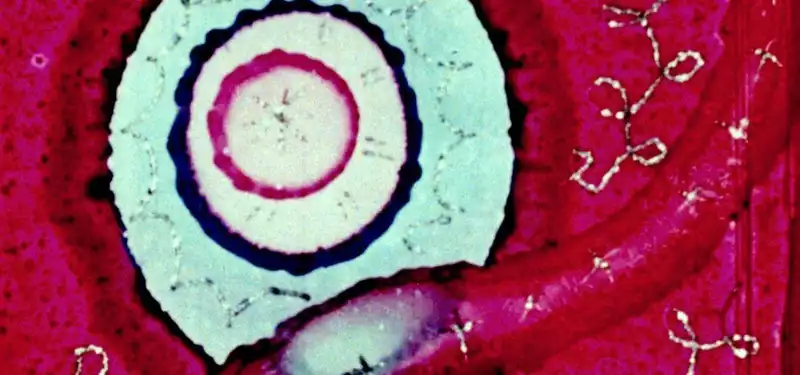Nov 2, 2020
The Anime that Changed Me: Kim Keukerer on BEGONE DULL CARE
This week's "Animation That Changed Me" features Kim Keukerer from Brussels. One of Europe's leading stop-motion animators, Keukerer's credits include "Chicken Run," "Frankenweenie," "My Life as a Zucchini," "Fantastic Mr. Fox" and "Isle of Dogs." She has worked with companies such as Passion Pictures, BBC Animations, Aardman, Cosgrove Hall, and Will Vinton Studios.
She chose Begone Dull Care, a 1949 short directed by the great experimental animator Norman McLaren and (uncredited) Evelyn Lambert for the National Film Board of Canada. The images were drawn and engraved on film, with music by the Oscar Peterson Trio. That was Keukerer:
I first saw this film when I was a student at La Cambre in Brussels, majoring in animation, around 1988, I think. It was part of a Norman McLaren retrospective at the Annecy Film Festival. His whole body of work was a huge mind-opener, but this film had everything for me: experimentation, creativity, images, sound, movement, rhythm, tempo, dynamics, pace, energy. Very rich. The originality, the diversity of techniques, the creativity, the music and soundtrack work may have made an impact. I was impressed not only by one film, but by his work in general. He also made films where he would draw his own soundtracks, which was really cool to me as well.
Animation culture was almost non-existent back then, and the Internet didn't exist. Digital was not very accessible, everything was shot on film, VFX and post-production was very expensive and not on the same scale as it is now. Now you can do anything with CG, digital, and post-production without actually shooting anything.
Seeing something so different and creative made me realize that there is no limit to what can be done with animation, anything can be animated. Watching McLaren experiment was very exciting. Life and emotion coming from abstract forms.
The symbiosis between the images and the soundtrack was just beautiful. You can watch it without thinking, just contemplate, and follow it with your eyes and ears to see where it leads you. I realized how important music is in conveying mood and emotion. I'm more interested in moving emotions than moving objects.
Since then, music and soundtracks have always had an important place in my character animation work. When I animate, I think about how long this gesture will take, how many frames it will take to get from one position to another, how fast it will move, how fluidly everything will move, how synchronized the different gestures will be. Think about where the pauses, the silences, the breaths, the frenetic succession of beats, the high and low moments are, as in music, as in life.
Unfortunately, I cannot paint, so having another medium to express myself was very liberating. As a student, I had the time and space to experiment. I used a variety of mediums: cut-outs, painting and scratching on film, object animation, chalk. And I was always playing with soundtracks and music.
My dream was to become a musician and play the drums, but unfortunately I am not very good at music and I don't have much of a musical culture. I probably play my own music throughout my animations. Every movement I make in my animation is my own interpretation of life, divided by frames, number of frames, groups of frames.
When I look at a human being, I see many different movements. When I look at animators, I see their movements, because they have their own style. Each person has their own rhythm, their own music.
I like to compare animators to musicians. We play the same score, but each of us interprets it differently according to our individual personalities. The notes may be the same, but if played by different musicians, the music will be completely different. I believe that just as a conductor chooses musicians according to their style and the way they interpret music, so too does a director choose animators according to their personalities.
I also believe that animation is an alchemy between the director, the actors' voices and expressions, the puppets, and the animators. Just as there is alchemy between the conductor, the instruments, and the musicians. That's how magic is created.
I don't rewatch "Begon Dal Kea" often. What matters is the impact it had on me when I first saw it. I was young then, eager to learn (fortunately I still am), and my skills were vastly different. Young students who see the film now may find it too long and very old-fashioned.
.



Post your comment